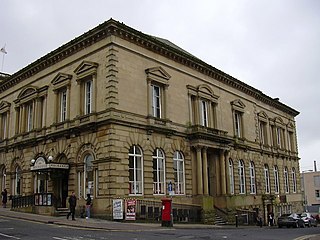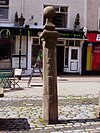
Poulton-le-Fylde, commonly shortened to Poulton, is a market town in Lancashire, England, situated on the coastal plain called the Fylde. In the 2021 United Kingdom census, it had a population of 18,115.

Elswick is a rural village and civil parish on the Fylde coast of Lancashire, England. At the 2011 Census, it had a population of 1,079.

Singleton is a village and civil parish in Lancashire, England. It is situated on the coastal plain called the Fylde. It is located south-east of Poulton-le-Fylde, and at the 2001 census had a population of 877, increasing to 889 at the 2011 Census. The parish is sometimes referred to as two parts – Great Singleton is the larger part containing the village, and Little Singleton is a small area north of the village bordering the River Wyre.

Blackpool is a seaside town and unitary authority situated on The Fylde coast in Lancashire, England. This list includes the listed buildings in Blackpool and Bispham, a village within the borough of Blackpool. One is classified by English Heritage as being in Grade I and five in Grade II*. In the United Kingdom, the term "listed building" refers to a building or other structure officially designated as being of special architectural, historical or cultural significance. These buildings are in three grades: Grade I consists of buildings of outstanding architectural or historical interest; Grade II* includes particularly significant buildings of more than local interest; Grade II consists of buildings of special architectural or historical interest. Buildings in England are listed by the Secretary of State for Culture, Media and Sport on recommendations provided by English Heritage, which also determines the grading.

St Chad's Church is an Anglican church in Poulton-le-Fylde, Lancashire, England. It is an active parish church in the Diocese of Blackburn and the archdeaconry of Lancaster. It is recorded in the National Heritage List for England as a designated Grade II* listed building. A church on the site was built no later than the 11th century and may have existed prior to the Norman conquest of England. The tower dates from the 17th century, and much of the remainder of the building from a major renovation in the 18th century, although some of the fabric of the original structure remains. Further renovation and additions took place in the 19th, 20th and 21st centuries.

The Church of St John the Evangelist is a Roman Catholic church in the market town of Poulton-le-Fylde, Lancashire, England. The current church replaced an earlier chapel which lies a few metres to the north-east. The former chapel, with its attached presbytery, has been designated a Grade II listed building by English Heritage.

Marton is a historic village on the coastal plain of the Fylde in the Borough of Blackpool in Lancashire, England, most of which is now forms a part of the town of Blackpool. Marton, consists of Great Marton, Little Marton, Marton Fold and The Peel.

Fleetwood is a fishing and market town within the Wyre district of Lancashire, England, lying at the northwest corner of the Fylde coast. All of the 44 listed buildings are recorded in the National Heritage List for England at Grade II.

St Peter's Church is in the seaside town of Fleetwood, Lancashire, England, situated on the Fylde coast. It is an active Anglican parish church in the Diocese of Blackburn. It was completed in 1841, to a design by Decimus Burton. Burton had been employed by Peter Hesketh-Fleetwood in 1836 to lay out the new planned town of Fleetwood. It is protected as a Grade II listed building.

The Burnley Mechanics is a theatre and former Mechanics' Institute in the market town of Burnley, Lancashire, England. It was built 1854–55 and converted to a theatre in 1979. Historic England has designated the theatre a Grade II* listed building.

Marsh Mill is an 18th-century tower windmill in Thornton, Lancashire, England. It was built in 1794 by Ralph Slater for local landowner Bold Hesketh. It functioned as a corn mill until the 1920s and has been fully restored. It is a good example of a complete English windmill and has been designated a Grade II* listed building.

Little Marton Mill is a 19th-century English tower windmill in Marton, Blackpool, Lancashire, England. It was built in 1838 by John Hays for grinding corn, and worked until 1928. It has been designated a Grade II listed building by Historic England.

Lancashire is a county in North West England. In 1974 parts of the historic county were divided between Greater Manchester, Merseyside, Cheshire and Cumbria, and part of the West Riding of Yorkshire was transferred into the county, creating the non-metropolitan county of Lancashire. Together with the unitary authorities of Blackburn with Darwen and Blackpool it now forms the ceremonial county of Lancashire.
Medlar-with-Wesham is a civil parish in the Borough of Fylde, Lancashire, England. It contains three buildings that are recorded in the National Heritage List for England as designated listed buildings, all of which are listed at Grade II. This grade is the lowest of the three gradings given to listed buildings and is applied to "buildings of national importance and special interest". The parish contains the town of Wesham, and is otherwise rural. The listed buildings consist of a farmhouse, a church, and a war memorial.
Ribby-with-Wrea is a civil parish in the Borough of Fylde, Lancashire, England. It contains four buildings that are recorded in the National Heritage List for England as designated listed buildings, all of which are listed at Grade II. This grade is the lowest of the three gradings given to listed buildings and is applied to "buildings of national importance and special interest". The parish includes the village of Wrea Green but is otherwise mainly rural. The listed buildings are a former farmhouse, a country house, a 19th-century house, and a church.
Morecambe is a seaside town in the City of Lancaster, Lancashire, England. It contains 43 buildings that are recorded in the National Heritage List for England as designated listed buildings. Of these, two are at Grade II*, the middle grade, and the others are at Grade II, the lowest grade. The town originated as a small fishing village called Poulton, and started to be used as a resort towards the end of the 18th century. It expanded during the 19th century, particularly following the arrival of the railway in 1850. The town was officially renamed Morecambe in 1889.

1 Vicarage Road is a Grade II listed building in the English market town of Poulton-le-Fylde, Lancashire. Built in 1839, it stands at the corner of Vicarage Road and Chapel Street. It directly across the latter from the Thatched House public house. Now an estate agent, the building was originally Poulton Savings Bank. It was the town's library in the 1880s.

Poulton-le-Fylde Market Cross, in the English market town of Poulton-le-Fylde, Lancashire, was likely erected in the 17th century. Standing at the southern end of Market Place, it is a Grade II listed structure.

Marsh Farmhouse is an historic building in Thornton-Cleveleys, Lancashire, England. Built in 1803, it is a Grade II listed building. It is located to the southeast of today's Amounderness Way roundabout at Victoria Road East.

2 Market Place is a Grade II listed building in the English market town of Poulton-le-Fylde, Lancashire. Built in the late 17th or early 18th century, it stands immediately to the south of St Chad's Church, itself Grade II* listed and dating to the 17th century, in the northeastern corner of Market Place. It was formerly a custom house, later a residence.




































